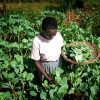Tuesday, May 14, 2024
News and Views from the Global South
ENVIRONMENT: Conservation Expands in Latin America
Marcela Valente* - Tierramérica
- In the past 10 years the size of protected areas in Latin America has nearly doubled and the participation of local communities in their preservation and management has sharply increased, says a regional study provided exclusively to Tierramérica.
But fossil fuel exploration and exploitation, agricultural expansion and large-scale infrastructure development all threaten conservation and bog down countries' efforts towards sustainable development, according to a preliminary draft of the study, which was based on national reports.
A draft of the document was presented at the opening of the 2nd Latin American Congress on National Parks and Other Protected Areas, running Sept. 30 to Oct. 6 in the mountain resort city of Bariloche, in southern Argentina.
The report, Diagnosis of the Current Situation of Protected Areas in Latin America and the Caribbean 2007, it is considered the baseline for understanding what is happening today and for defining future policies.
Since the first Latin American Congress on National Parks, held in 1997 in the northern Colombian city of Santa Marta, there has been a "substantial increase" in total protected area, from 160 million hectares to more than 300 million hectares, according to the draft. At the 4th World Parks Congress, in 1992, the Latin American areas reported as subject to protection did not reach 120 million hectares.
"This involves more than 10 percent of the total Neotropic area in its continental portion," estimates the expert who compiled the report, Colombian anthropologist Carlos Castaño Uribe, adviser to the United Nations Food and Agriculture Organisation (FAO).
The Neotropic ecozone extends from southern Mexico, includes all of Central America, the Caribbean and South America, encompassing the world's largest tropical forests.
Twelve countries report increases in total protected area. Brazil and El Salvador doubled it over the past decade. And nearly all Latin American countries surpass the international standard of 10 percent of national territory set aside as protected area, according to the report.
Venezuela is the leader in proportion of its territory considered protected area: 66 percent. Guatemala and Panama also stand out, with more than 30 percent each.
"The expansion of protected areas is one of the best indicators of the region's contribution to global conservation," the study states.
Through its Latin American Network of Technical Cooperation in National Parks, Protected Areas and Wildlife, known in Spanish as Redparques, FAO organised the meeting, along with the UN Development Programme (UNDP) and the South American office of the World Conservation Union (IUCN).
"The participation of local communities in coordination and management of the protected areas is increasingly common in nearly all countries of Latin America," says the study.
Some examples are the Bolivian development policies involving indigenous peoples and peasant farmers (campesinos), the Venezuelan Tree Mission, Colombia's Parks with People programme, and the participation of rural Mexican women in conservation efforts.
Private nature reserves have also taken on "a very important role," according to the document. The region's countries report 2,296 privately-held protected areas, covering nearly three million hectares. Chile is the leader in this category, with 1.7 million hectares.
Biological corridors that connect conservation areas also gained ground, but many are still in the process of being created. The number of existing corridors is far fewer than the total proposed at the local, regional and international level. "It is a strategy that is generating great expectations," according to the author.
Also in nascent stages are coastal parks. Such protected areas exist in Cuba, Chile, the Dominican Republic and Guatemala, but there are similar projects on the drawing board in other countries, such as Argentina.
Progress has been made institutionally as well since 1997. In eight Latin American countries, environment ministries were created or park administration agencies were elevated in the national government hierarchy. Most have specific laws on protected areas, and five include them in their national development plans.
Each has different systems for regulating and evaluating the effectiveness of their management plans.
But when it comes to monitoring, lack of resources is a problem, especially in countries with the largest areas under preservation. Although the study does not delve into this issue, it reports that, on average, in Latin America there is one park ranger for approximately every 30,000 hectares.
The disparity is greatest in Brazil, with one ranger per 111,000 hectares, and smallest in El Salvador, with one for every 350 hectares. Despite the fact that most countries say they have increased their budgets for such purposes, there is a great need for trained personnel and for equipment.
The report's compiler Castaño Uribe maintains that ecological tourism programmes have been a boon to the notable increase in protected areas over the past five to 10 years, and he believes that the activity could become "an important source of sustainability and financial independence" for those areas.
Among the ongoing threats to protected areas are fossil fuel exploration and exploitation, mining, farm and livestock expansion, new infrastructure, deforestation and forest fires, unsustainable tourism and fishing, overexploitation of biodiversity and water, poverty and population increases, land conflicts, and soil erosion.
Several countries report a lack of legislation, institutional weakness, and a need for more trained personnel among the challenges seeking responses at the conference in Bariloche.
Attending are more than 2,000 officials, academics, conservationists, tourism operators, and representatives of indigenous, black, fishing and campesino communities.
(*Originally published by Latin American newspapers that are part of the Tierramérica network. Tierramérica is a specialised news service produced by IPS with the backing of the United Nations Development Programme and the United Nations Environment Programme.)

 Print
Print



